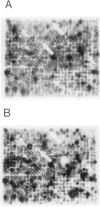Abstract
The areA gene, which mediates nitrogen metabolite repression in the fungus Aspergillus nidulans, lies sufficiently close to a telomere that no indispensable gene can be distal to it. We were able therefore to exploit the existence of a near terminal pericentric inversion to devise a method for cloning areA plus the region beyond it towards the telomere. In crosses heterozygous for this inversion a class of duplication-deficient progeny lacking areA and the region centromere-distal to it is obtained. We, therefore, sought clones from an A. nidulans gene library in lambda Charon 4 able to hybridize to total genomic DNA from a wild-type strain but not to that from a duplication-deficiency strain. A clone, containing an 11.6-kb insert, which hybridised weakly to duplication-deficiency DNA, overlapped chromosome breakpoints of three different aberration-associated areA alleles and was able to transform an areA mutant to areA+. Southern blotting and genetic analysis established that the transforming sequence had integrated in the region centromere distal to areA. The cloning method yielded other clones from the region centromere-distal to areA which were used to show that the translocation associated with a mutant areA allele is reciprocal rather than non-reciprocal, a fact which could not be established by classical genetics. Finally, analysis of the cloned portion of the dispensable region centromere-distal to areA indicates that this region contains at least 0.5% of the A. nidulans genome.
Full text
PDF



Images in this article
Selected References
These references are in PubMed. This may not be the complete list of references from this article.
- Arst H. N., Jr A near terminal pericentric inversion leads to nitrogen metabolite derepression in Aspergillus nidulans. Mol Gen Genet. 1982;188(3):490–493. doi: 10.1007/BF00330054. [DOI] [PubMed] [Google Scholar]
- Arst H. N., Jr, Cove D. J. Nitrogen metabolite repression in Aspergillus nidulans. Mol Gen Genet. 1973 Nov 2;126(2):111–141. doi: 10.1007/BF00330988. [DOI] [PubMed] [Google Scholar]
- Arst H. N., Jr, Scazzocchio C. Initiator constitutive mutation with an 'up-promoter' effect in Aspergillus nidulans. Nature. 1975 Mar 6;254(5495):31–34. doi: 10.1038/254031a0. [DOI] [PubMed] [Google Scholar]
- Ballance D. J., Turner G. Development of a high-frequency transforming vector for Aspergillus nidulans. Gene. 1985;36(3):321–331. doi: 10.1016/0378-1119(85)90187-8. [DOI] [PubMed] [Google Scholar]
- Cove D. J. The induction and repression of nitrate reductase in the fungus Aspergillus nidulans. Biochim Biophys Acta. 1966 Jan 11;113(1):51–56. doi: 10.1016/s0926-6593(66)80120-0. [DOI] [PubMed] [Google Scholar]
- Feinberg A. P., Vogelstein B. "A technique for radiolabeling DNA restriction endonuclease fragments to high specific activity". Addendum. Anal Biochem. 1984 Feb;137(1):266–267. doi: 10.1016/0003-2697(84)90381-6. [DOI] [PubMed] [Google Scholar]
- Henson J. M., Kuempel P. L. Deletion of the terminus region (340 kilobase pairs of DNA) from the chromosome of Escherichia coli. Proc Natl Acad Sci U S A. 1985 Jun;82(11):3766–3770. doi: 10.1073/pnas.82.11.3766. [DOI] [PMC free article] [PubMed] [Google Scholar]
- Käfer E. Meiotic and mitotic recombination in Aspergillus and its chromosomal aberrations. Adv Genet. 1977;19:33–131. doi: 10.1016/s0065-2660(08)60245-x. [DOI] [PubMed] [Google Scholar]
- Meinkoth J., Wahl G. Hybridization of nucleic acids immobilized on solid supports. Anal Biochem. 1984 May 1;138(2):267–284. doi: 10.1016/0003-2697(84)90808-x. [DOI] [PubMed] [Google Scholar]
- Orr W. C., Timberlake W. E. Clustering of spore-specific genes in Aspergillus nidulans. Proc Natl Acad Sci U S A. 1982 Oct;79(19):5976–5980. doi: 10.1073/pnas.79.19.5976. [DOI] [PMC free article] [PubMed] [Google Scholar]
- PONTECORVO G., ROPER J. A., HEMMONS L. M., MACDONALD K. D., BUFTON A. W. J. The genetics of Aspergillus nidulans. Adv Genet. 1953;5:141–238. doi: 10.1016/s0065-2660(08)60408-3. [DOI] [PubMed] [Google Scholar]
- Perkins D. D., Barry E. G. The cytogenetics of Neurospora. Adv Genet. 1977;19:133–285. doi: 10.1016/s0065-2660(08)60246-1. [DOI] [PubMed] [Google Scholar]
- Rand K. N., Arst H. N., Jr A mutation in Aspergillus nidulans which affects the regulation of nitrite reductase and is tightly linked to its structural gene. Mol Gen Genet. 1977 Sep 21;155(1):67–75. doi: 10.1007/BF00268562. [DOI] [PubMed] [Google Scholar]
- Rand K. N., Arst H. N., Jr Mutations in nirA gene of Aspergillus nidulans and nitrogen metabolism. Nature. 1978 Apr 20;272(5655):732–734. doi: 10.1038/272732a0. [DOI] [PubMed] [Google Scholar]
- Shaffer P. M., Arst H. N., Jr Regulation of pyrimidine salvage in Aspergillus nidulans: a role for the major regulatory gene are A mediating nitrogen metabolite repression. Mol Gen Genet. 1984;198(2):139–145. doi: 10.1007/BF00328713. [DOI] [PubMed] [Google Scholar]
- Southern E. M. Detection of specific sequences among DNA fragments separated by gel electrophoresis. J Mol Biol. 1975 Nov 5;98(3):503–517. doi: 10.1016/s0022-2836(75)80083-0. [DOI] [PubMed] [Google Scholar]
- Timberlake W. E. Low repetitive DNA content in Aspergillus nidulans. Science. 1978 Dec 1;202(4371):973–975. doi: 10.1126/science.362530. [DOI] [PubMed] [Google Scholar]
- Wiame J. M., Grenson M., Arst H. N., Jr Nitrogen catabolite repression in yeasts and filamentous fungi. Adv Microb Physiol. 1985;26:1–88. doi: 10.1016/s0065-2911(08)60394-x. [DOI] [PubMed] [Google Scholar]
- de Wet J. R., Daniels D. L., Schroeder J. L., Williams B. G., Denniston-Thompson K., Moore D. D., Blattner F. R. Restriction maps for twenty-one Charon vector phages. J Virol. 1980 Jan;33(1):401–410. doi: 10.1128/jvi.33.1.401-410.1980. [DOI] [PMC free article] [PubMed] [Google Scholar]





